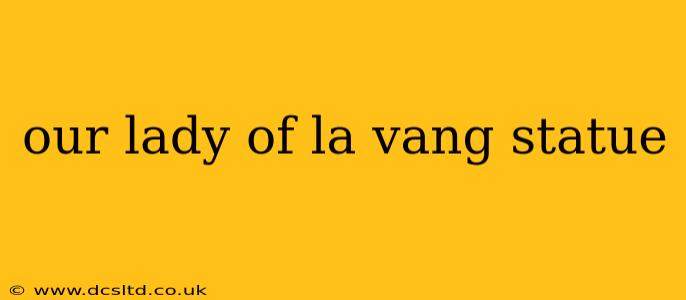The Our Lady of La Vang statue stands as a powerful symbol of faith, resilience, and hope for Vietnamese Catholics worldwide. More than just a religious icon, it represents a significant moment in Vietnamese history and the enduring spirit of a people. This article delves into the history, significance, and various representations of the Our Lady of La Vang statue, answering some frequently asked questions along the way.
What is the significance of Our Lady of La Vang?
Our Lady of La Vang is the title given to the Blessed Virgin Mary, whose apparition is said to have occurred in the La Vang forest during the early 18th century. During a period of intense persecution of Christians in Vietnam, many Catholics fled to the forest for refuge. Facing hunger, disease, and relentless pursuit, they prayed fervently for divine intervention. It was during this time that the Virgin Mary is said to have appeared, offering comfort and healing. This miraculous intervention is credited with strengthening the faith of the persecuted Christians and bolstering their resolve. The subsequent devotion to Our Lady of La Vang has grown significantly over the centuries, making her a central figure in Vietnamese Catholic culture.
Where is the original Our Lady of La Vang statue located?
The original statue, as many believe it, no longer exists. The story of Our Lady of La Vang originates from oral tradition passed down through generations. The initial images were likely simple, created by the refugees themselves. However, numerous statues of Our Lady of La Vang exist today, both in Vietnam and across the globe. These statues often depict Mary holding the infant Jesus, sometimes surrounded by angels or with other symbolic elements reflecting the apparition story.
What does the Our Lady of La Vang statue look like?
While there's no single definitive representation, most statues of Our Lady of La Vang depict Mary in a gentle and compassionate manner. She's frequently shown holding the Christ Child, often dressed in flowing robes, sometimes incorporating elements of Vietnamese clothing or aesthetics. The style can vary depending on the artist and the specific location of the statue, but the overall feeling is one of peace and maternal protection. The settings of the statues may differ as well, from simple backdrops to elaborate scenes reflecting the original La Vang forest setting.
What is the history of the Our Lady of La Vang Shrine?
The devotion to Our Lady of La Vang led to the establishment of the National Shrine of Our Lady of La Vang in Quảng Trị Province, Vietnam. While initial devotions took place in the forest, the shrine’s development occurred gradually over time, culminating in a significant pilgrimage site today. This shrine has become a focal point for millions of pilgrims each year, coming to pay their respects and seek divine intervention. The construction and expansion of the shrine reflect the evolving faith and cultural significance of Our Lady of La Vang.
Is there a specific prayer to Our Lady of La Vang?
While there isn't a single, universally recognized prayer specifically titled "Prayer to Our Lady of La Vang," numerous prayers exist invoking her intercession. These prayers are typically addressed to Mary, asking for her help, protection, and guidance in various aspects of life. Many prayers incorporate aspects of the original apparition story and the themes of hope, faith, and resilience. These prayers are often recited at the National Shrine and in homes across the Vietnamese diaspora.
What are the different representations of the Our Lady of La Vang?
The representation of Our Lady of La Vang varies widely. While the core elements—Mary with the infant Jesus—remain consistent, stylistic choices differ across statues. Some statues are highly realistic, while others are more stylized. Local artisans frequently incorporate cultural elements, reflecting the geographical location where the statue was created. The differences in representation underscore the widespread devotion and the diverse ways in which people express their faith. These variances highlight the adaptability of religious iconography within a specific cultural context.
The Our Lady of La Vang statue is more than just a piece of religious art; it is a living testament to faith, perseverance, and the enduring strength of the human spirit in the face of adversity. Its enduring popularity reflects the deep cultural and religious significance it holds for millions around the world.
